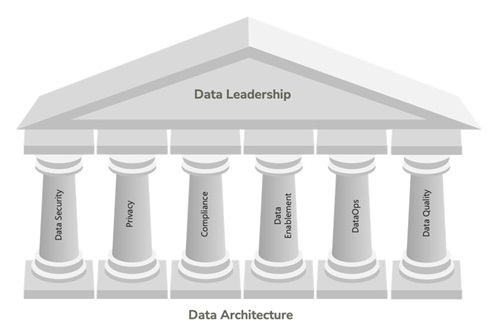
The House of Data and Data Stewardship with Dr. James Barker
Dr. James Barker, director of professional services for data strategy with Alation, discusses the “House of Data,” including key concepts, stewardship roles, and data councils.
- By Upside Staff
- November 2, 2023
In this recent “Speaking of Data” podcast, Dr. James Barker discusses the framework for data and analytics he calls “the House of Data.” Barker is director of professional services for data strategy with Alation. [Editor’s note: Speaker quotations have been edited for length and clarity.]
“The House of Data is loosely based on Toyota’s House of Quality, which was a hot topic when I got my master’s degree,” Barker began. “When I was at Honeywell getting their first data governance council going, we had a diagram that included things such as master data management (MDM), data quality, standards, and enforcement as part of it, but it really wasn’t resonating with people. Then I saw an example of a pillar diagram at a conference and took it back to my team to apply to our work.”
The original House of Data diagram had four pillars -- data quality, data security, MDM, and compliance -- with data architecture as the floor and the governance council itself as the roof. Shortly after that, Barker started work on his doctoral dissertation using the diagram as the conceptual framework.

“As time has gone on,” said he says, “the diagram has evolved. MDM is now DataOps, we’ve added privacy and data enablement to make six pillars, and the roof has been renamed ‘data leadership.’” The idea behind the House of Data, he added, is that it shows all the different personas that need to be assembled to run a successful data program.
Barker took a moment to dig deeper into one of the particular roles -- that of data steward. There are essentially three types of stewards:
- Business data stewards . These are the rank-and-file people who are basically doing the work with the data. They are the ones with the long histories with the organization and are often the hardest people to replace.
- Technical data stewards . These are people more on the engineering side of things. They generally resist being called “stewards,” preferring to be called data architects or engineers. The best organizations are those where the business and technical stewards work well and closely with each other, regardless of title.
- Enterprise data stewards . Not many companies have this role, of if they do, they’re not aware of it. This person is at the right hand of the CDO, knows the strategic direction, and can coordinate the input from the CDO and all the other stewards and engineers.
Another topic that Barker looked deeply into was that of governance councils.
“I spoke at a conference recently, and the first question at the Q&A section was about councils. I told them about the “3+ model” of governance. At the primary level, you have your lead data stewards working together to keep things moving forward, whether aligned around a specific function (such as finance or manufacturing) or around a line of business. This type of council works best at large organizations, includes a mix of LOB and functional representation, and often meets weekly to stay up to date on what’s working and what’s not. They’re generally the ones who keep things aligned and moving forward.
“Above that, you have what can be considered a steering committee,” Barker continued. “That tends to be made up of the managers of the lower-level committee members, who hear from the top what’s really happening and what the strategic direction looks like but are also still close enough to the primary governance council that they have an idea of what those stewards are going through on a daily basis. This group tends to meet monthly.”
“Then, you have the executive steering group. This group includes VPs or C-level executives who meet quarterly to discuss the overall data governance road map and to take steps to clear any persistent roadblocks. This group needs regular updates from the data teams to do their work.” Barker recommended maintaining a “state of data” report that is kept up to date by the data teams and reflects the organization’s 30-, 60-, and 90-day plans.
Barker concluded by explaining the “plus” -- temporary “tiger teams” that are assembled for specific initiatives or challenges and then disassembled once the goal has been met and the solution has been communicated to the necessary parties.
When it comes to setting up these new organizational structures, Barker had a few ideas for that as well.
“One way is when someone with enough clout just brings the necessary people together and gets it rolling,” he said. “Another way is to trick people, as it were. For example, you start with a specific challenge -- say, setting up a data intelligence function -- and you get people together across all different groups to share and collect input. Then, a month later, you have another meeting with the same group to go over where you are now and update them about future plans. After two or three such meetings, you tell them you’re interested in making it a more formal arrangement and hope you get buy-in.” At the executive level, Barker added, you can sometimes start by tagging along with a council that already exists.